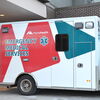Take advantage of new tax incentives for year-end equipment financing
 Stephen Krolikowski
Stephen Krolikowski
Forward-thinking business leaders should consider acquiring new or updated equipment before the end of 2016 to take advantage of legislation that both expands deductions and extends depreciation benefits for qualifying equipment purchases. Tax benefits and favorable pricing make the fourth quarter of the year a particularly lucrative time for businesses to finance new or upgraded equipment.
Financing capital equipment enables businesses to conserve cash and lines of credit while providing maximum flexibility. Entering into a finance agreement at the end of the year is also a smart way for companies to use any remaining capital budget while preparing for the year to come. Consider these factors when determining whether investing in capital equipment during the fourth quarter of the year aligns with your company's strategic goals:
Incentives for small businesses
Internal Revenue Service Code Section 179 is an incentive created to encourage businesses to invest in capital equipment. It covers accelerated write-offs for capital purchases and is particularly beneficial to smaller businesses with limited budgets.
Effective Jan. 1, 2016, businesses that purchase $2 million or less in capital equipment can deduct up to $500,000 of that expense immediately on their 2016 tax return. Financing can further enhance the bottom line by eliminating the upfront cash outlay typical of an equipment purchase while still preserving the Section 179 deduction. However, equipment must be financed and in place by midnight Dec. 31, 2016, in order to qualify for the 2016 tax year.
Companies requiring more than $2 million in capital equipment investment in 2016 will need to manage the tax ownership of those additional assets in order to maintain a Section 179 write-off (there is a dollar-for-dollar phase-out of the deduction for purchases exceeding the $2 million threshold). By using a tax lease for assets exceeding the $2 million threshold, the leasing company becomes the tax owner of the equipment, which allows businesses to maintain the maximum Section 179 deduction.
Extended Bonus Depreciation
Under the same tax legislation, businesses of all sizes can depreciate 50% of the cost to acquire eligible equipment on their 2016 tax returns. This tax break has been extended through 2019, although it will phase down to 40% in 2018 and 30% in 2019.
For many businesses, asset depreciation plays an important role in fiscal management. Most equipment acquisitions offer depreciation benefits, but determining whether a company can effectively use all of that depreciation requires some consideration.
This is especially true for equipment-intensive businesses. Full taxpayers in need of the sheltering effect of equipment depreciation will typically benefit from tax ownership of equipment. This can be accomplished with a loan, installment payment agreement and some leases. All of these options allow the user to deduct depreciation and interest charges from taxable income.
Companies with a more complex tax situation may want to consider a tax lease. Tax leases effectively trade tax depreciation for lower payments. Plus, tax leases allow the entire lease payment to be deducted as an operating expense.
Leasing allows a company the freedom to obtain the equipment it needs, when it is needed. With tax leases, companies avoid the fourth-quarter asset acquisition restrictions, yet still receive the tax advantage in the form of lower payments — because the lessor records the ownership of the asset(s) and resulting depreciation. Leasing can be a helpful option when project delays or unexpected equipment replacement needs arise in the fourth quarter.
There are many reasons to finance equipment at any time of the year, but companies interested in taking advantage of expanded tax benefits for 2016 and getting a head start on next year should consider financing new or updated equipment before Dec. 31. It may be the best decision you make all year.
Stephen Krolikowski is senior vice president and business banking team leader for KeyBank's Maine market. He can be reached by phone at 207-874-7265 or email at stephen_krolikowski@keybank.com









Comments